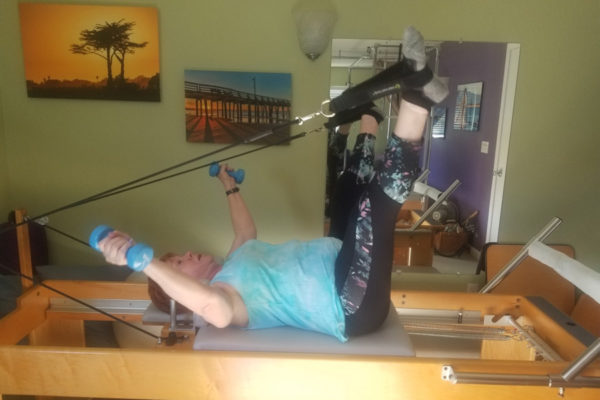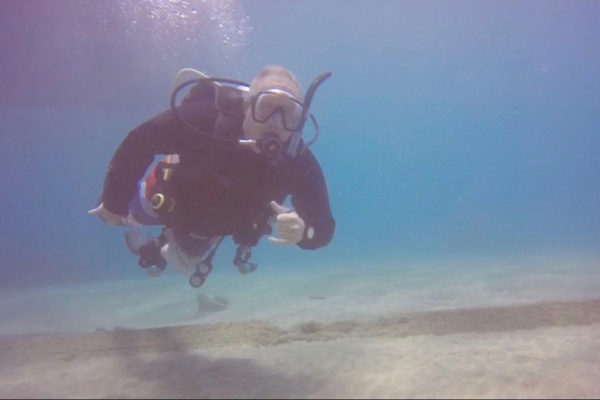A Golden Era of Cell-Assisted Memory and Vascular Health
Sam’s Patient Reported Outcome
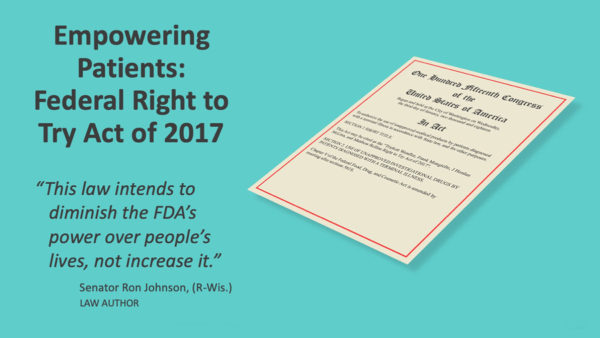 Sam was a productive dentist, recreational golfer, proud parent, and happy husband. However, in 2013 his wife Flo, a retired physician, began a bold twenty-year battle to reverse his dementia, vascular disease, and pre-diabetes. In April 2020, Sam suffered a stroke and contracted Covid and pneumonia in the hospital. He remained there for two months.
Sam was a productive dentist, recreational golfer, proud parent, and happy husband. However, in 2013 his wife Flo, a retired physician, began a bold twenty-year battle to reverse his dementia, vascular disease, and pre-diabetes. In April 2020, Sam suffered a stroke and contracted Covid and pneumonia in the hospital. He remained there for two months.
In March 2022, Sam and his wife, Flo, exercised Sam’s Right-to-Try AMBROSE Cell Therapy. Seven months later, he stated, “I am a new man. I have much more energy. My thinking is clearer. I was worried about myself at one time, but not anymore.”
We will return to Sam’s story in a moment; first, some background on the power of blood flow and the risks of ischemia (lack of blood flow).
Sam’s Lifeblood –
Ancient Eastern societies (Phoenicians, Persians, Egyptians, and Hebrews) attached beliefs about blood to the origins of religion. Some Greek savants considered blood the same as the soul or spirit.
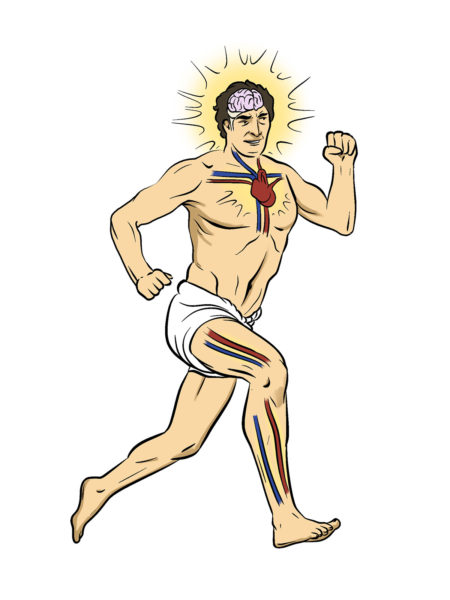 Further, the Greeks developed the first scientific considerations about blood. Back in Homer’s time (8th or 9th Century BC), they summarized four concepts that remain valid to day:
Further, the Greeks developed the first scientific considerations about blood. Back in Homer’s time (8th or 9th Century BC), they summarized four concepts that remain valid to day:
a) Blood is essential for life
b) Death is considered final when a lack of blood causes it
c) Clashes in which murder and blood make their appearance are horrible
d) Tribes, nations, and families regard blood as a bond
Finally, the Greeks believed good and virtuous blood characterized a courageous, valiant, and principled person.[1]
Following the Ancients’ theme, Merriam-Webster defines lifeblood as “the seat of vitality.”
Ischemia – Sam’s life suck In 1885, Rudolph Virchow coined “ischemia” to characterize the lack of blood flow in an organ or tissue. In plain words, ischemia means blood is not moving through your capillaries, blood vessels, veins, or arteries.
In 1885, Rudolph Virchow coined “ischemia” to characterize the lack of blood flow in an organ or tissue. In plain words, ischemia means blood is not moving through your capillaries, blood vessels, veins, or arteries.
The Po River nourishes Northern Italy’s expansive farms. But 2022’s global heat wave starved Italy’s breadbasket of vital nutrients and harmed the economy,
Similarly, Sam’s blood flow feeds his cells, tissues, and organs, but inflammation-induced ischemia sucked the vitality from Sam’s life.
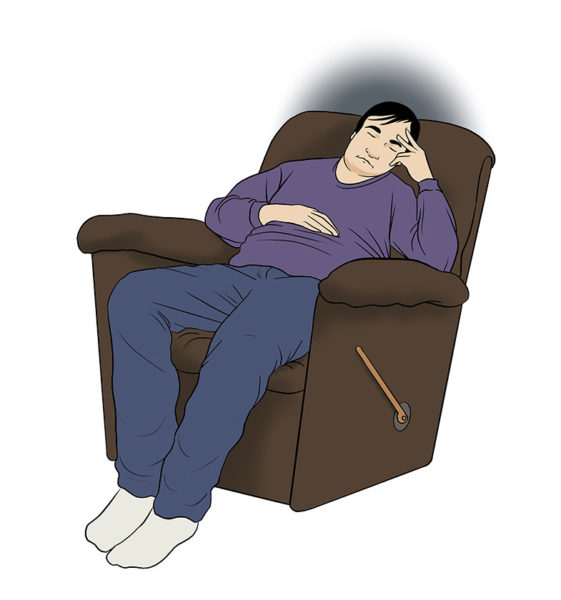 Sam’s long decline
Sam’s long decline
- Ten years of smoking
- Decades-long mercury exposure from practicing dentistry; he retired in 2008
- He ate the standard American diet (SAD) plus over-indulged in mercury-laden sushi.
- In 2002, he had surgeries for a torn rotator cuff and a fractured left wrist.
- In 2013, a noticeable cognitive decline set in. His Montreal Cognitive Assessment or the MoCA Test— had diminished to 16 out of 30, or about half of normal. MoCA is the most sensitive test available for measuring dementia.[2]
- In 2016, Sam’s doctors diagnosed him with vascular dementia and pre-diabetes.
- Somewhere along the line, he developed chronic lower back pain.
- In 2020, he suffered an ischemic stroke and contracted Covid and pneumonia in the hospital, where he remained for an additional two months.
In short, Sam’s diffuse (widespread) vascular, metabolic, and musculoskeletal disease foretold of dementia and the stroke yet to come.[3] [4]
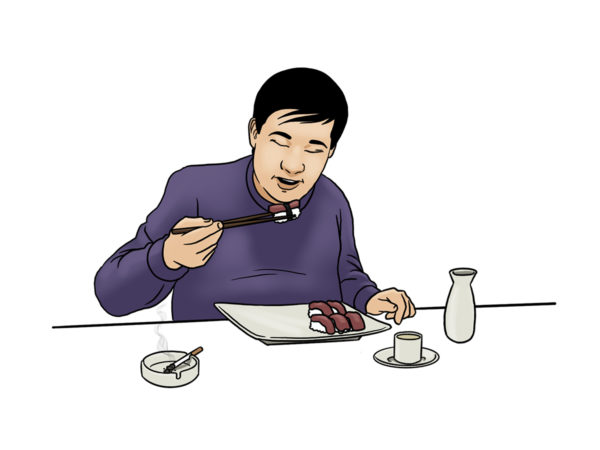 Sam’s history epitomizes the complexity of age-related ill health:
Sam’s history epitomizes the complexity of age-related ill health:
- Many of the factors associated with heart disease – for instance, high blood pressure, high cholesterol, and smoking are evident in patients with dementia and Alzheimer’s Disease (AD).
- A common cause of dementia is cerebrovascular disease or damage to the blood vessels in the brain.
- Elevated mercury levels are a less well-discussed culprit of heart disease and neurodegenerative conditions.
- The risk of vascular dementia increases with a stroke.
Flo’s Relentless Quest
In 2016, Flo found Dr. Dale Bredesen and the RECODE protocol. For several years Sam responded to RECODE. His MoCA score improved from 16 to 19.
Unfortunately, Sam’s vascular disease caught up with him in early 2020. He had a stroke and contracted Covid and pneumonia in the hospital, requiring a two-month stay. Research has since revealed that the Corona-19 virus attacks the endothelium (inner lining of the blood vessels), adding more risk to Sam’s future. [5]
In 2021, Flo, a retired physician, became concerned that her husband had plateaued. After researching stem cell therapy options, she recommended Ambrose Cell Therapy to Sam in 2022.
Sam’s Disease Progression
Sam’s first sign of ischemia was elevated blood pressure or hypertension (HTN). “His BP became a problem at least ten years ago.”, recalled Flo.
Cardiologists refer to HTN as the silent killer because it leads to heart attacks and strokes.
From 2009 to 2019, the deaths attributable to high BP rose by two-thirds, an astonishing number considering that one in four adults take antihypertensive medications.[6] [7]
- Every cigarette Sam or anyone smokes causes a temporary rise in blood pressure. And smoking leads to hardening and narrowing of the arteries (atherosclerosis). Thus, a smoker’s blood is more likely to clot, forcing the heart to work harder.
- Mercury toxicity correlates with hypertension, coronary heart disease, cerebrovascular incidents, and atherosclerosis.
- Insulin resistance, i.e., pre-diabetes, is associated with low cerebral blood flow (perfusion).
- Pre-diabetes, a hallmark of metabolic syndrome, links to vascular dementia. [8] [9] [10] [11] [12]
Flo’s Distrust
Flo, a retired physician, lacked confidence in the standard-of-care drugs, e.g., Donepezil (Aricept) and Memantine (Namenda). “I didn’t let the doctors put Sam on those medications. I saw they had short-term benefits but could make things worse with long-term use.”
A British study published in 2004 suggested that Aricept has “disappointingly little overall benefit and is not worth the cost.”
 Flo also knew to steer clear of drug combinations, including anti-depressants, anti-psychotics, anti-seizure, and sleep meds (polypharmacy). Neurologists prescribe polypharmacy to patients with neurodegenerative diseases despite its well-documented contribution to the progression and severity of dementia. In other words, drug companies profit, and patients pay the price. [13] [14] [15] [16]
Flo also knew to steer clear of drug combinations, including anti-depressants, anti-psychotics, anti-seizure, and sleep meds (polypharmacy). Neurologists prescribe polypharmacy to patients with neurodegenerative diseases despite its well-documented contribution to the progression and severity of dementia. In other words, drug companies profit, and patients pay the price. [13] [14] [15] [16]
In May 2022, Sam presented to Ambrose with:
- Vascular dementia
- Post-stroke left-side imbalance and difficulty swallowing
- Elevated blood pressure, controlled with medication (Losartan)
- High cholesterol
- Pre-diabetes HbA1C 6.3, fasting glucose 106.
- High inflammatory markers, including homocysteine – 8.4
- Chronic lower back pain
- Shoulder arthritis
- Reclusive and depressed
Harnessing Sam’s Innate Biology Flo believed in the body’s power to heal itself. That is why she was attracted to the RECODE protocol.
Flo believed in the body’s power to heal itself. That is why she was attracted to the RECODE protocol.
After Sam’s improvement stalled, she took the logical next step of researching stem cell therapy. But Google search results ranked common misinformation high. “Aren’t umbilical cord stem cells (UBSCs) more potent and effective than fat stem cells?” she asked.
Our critical review of Tony Robbin’s Life Force sets the record straight: Researchers have established that ADRCs are the most accessible, abundant, and potent cell population. Contrary to the extant dogma, stem cell depletion does not apply to ADRCs.[17]
Dozens of peer-reviewed studies supported the potential to treat Sam’s combined disabilities in a single outpatient procedure.
Making an informed choice Flo requested papers supporting potential benefits for Sam’s memory.
Flo requested papers supporting potential benefits for Sam’s memory.
- In 2017 the University of Louisville’s Cardiovascular Innovation Institute demonstrated that intravenous delivery of ADRCs could improve blood vessel health. They predicted “the intravenous delivery of this therapeutic cell population would significantly improve tissue perfusion (the passage of blood), particularly in diseases with diffuse (widely spread) vascular involvement.”[18]
- A just-published Japanese poster presentation reported remarkable improvements in MOCA scores after IV infusion of adipose-derived–mesenchymal stem cells (ADSCs or Ad-MSC).[19]
- Another study out of Japan demonstrated, “Treatment with Ad-MSC significantly improved HDL, LDL, and remnant-like particle (RLP) cholesterol levels…These findings suggest that Ad-MSC administration is safe and effective in patients developing arteriosclerosis, thereby providing an attractive tool for anti-aging application.[20]
- Japanese researchers from Nagoya University concluded in a 2022 review article, Adipose-derived regenerative cells as a promising therapy for cardiovascular diseases: an overview, “Therapeutic angiogenesis (new blood vessel growth) has been developed as a new treatment strategy for such patients.” [21]
Ischemia – the Tip of the Iceberg
A robust body of literature confirms that ischemia is just the tip of the dementia iceberg. As we have discussed in articles on cell-assisted brain care, aging, and long-Covid recovery, chronic disease involves multisystem dysregulation.

A Golden Era of Self-Cell Repair details the research and discovery path upon which we base Ambrose Cell Therapy’s safety and potential effectiveness. [22]
Sam’s Personalized Protocol Per the Ambrose Master Protocol:
Per the Ambrose Master Protocol:
- Ambrose’s board-certified plastic surgeon harvested 370 ccs of adipose tissue. The Celution™ System processed 310 ccs yielding 68 million ADRCs with 92% viability.
- Ambrose’s fellowship-trained interventional pain specialist utilized the remaining 60 ccs to deliver 44 injections of PRP-enriched micro-fat:
- Para-spinal and para-facet injections -24
- Right shoulder -13
- Left wrist – 7
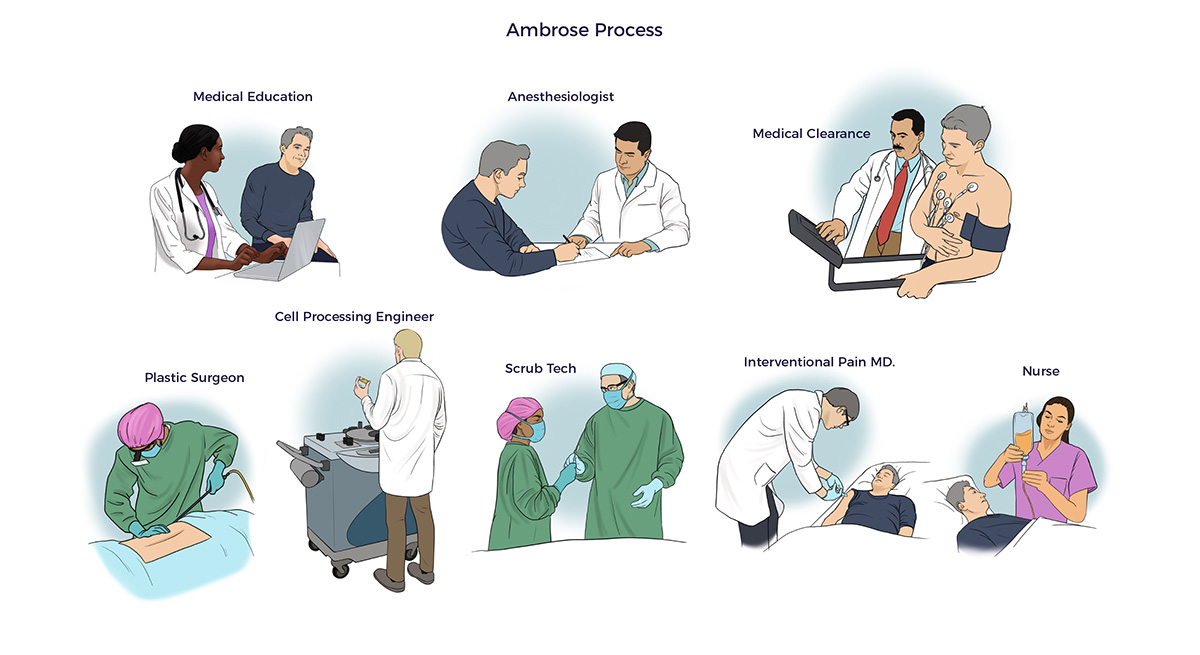
Summary of Benefits
Per Flo, over ten months, Sam went from reclusive, demented, and in chronic back pain to socializing with friends, playing an occasional round of golf, and enjoying his grandchildren.
He helps Flo with chores and preparing dinner and takes the initiative to attend church, meditate, and exercise. He engages in conversation without repeating himself. Flo wants to see his short-term memory improve but acknowledges Sam’s significant quality of life improvement.
 Consistent with the studies Ambrose provided to Flo, objective evidence indicates cell therapy lowered Sam’s risk of another catastrophic stroke or a heart attack.
Consistent with the studies Ambrose provided to Flo, objective evidence indicates cell therapy lowered Sam’s risk of another catastrophic stroke or a heart attack.
- His blood pressure normalized -120/80 or better most days – allowing him to discontinue losartan in the first few weeks following Sam’s Ambrose.
- His metabolic health and systemic inflammation showed remarkable improvement.
- HbA1C – 6.4 to 5.3
- Fasting glucose – 106 to 99
- Homocysteine – 8.4 to 6.0
Sam’s cholesterol remained high until Flo put him on Zetia and a low dose of Crestor. The keto diet raises cholesterol in some and lowers it in others.
Setbacks
To be clear, Sam has had a few setbacks, including a bout of severe constipation. Diet changes resolved that issue.
He also had a flare of debilitating back pain. Notably, his current MRI shows multi-level spinal degeneration and facet arthritis. However, his months of better function, including long walks and restarting golf, lend credence to the Ambrose Cell-Assisted Spine Care Hypothesis.
With rest and conservative physical therapy, Sam said, “My back is better.” He resumed his daily walks a few weeks later.
Sam’s Perspective
“Stem cells are the future. I am a new man. I have much more energy. I am thinking much more clearly. I was worried about myself at one time, but not anymore.”
“It’s going well. I am doing very much better. I am playing golf. We are visiting our son and grandchildren in Hamptons this weekend,” declared Sam.

He had quit golf four years ago and had not visited his family in several years.
Details – Sam’s improving quality of life timeline (edited for brevity and clarity):
- April: Not repeating questions as often, short-term memory starting to improve. Sam’s masseuse noted he didn’t repeat the same question. And Sam asked about her daughter for the first time. He initiated going to exercise, church, and meditating.
- His blood pressure normalized. He discontinued losartan.
- May – Sam surprised Flo with Mother’s Day Flowers and teased her that her boyfriend from high school must have sent them.
- June – He played golf after quitting four years ago. Flo: “Good news Matt, we played golf – 9 holes, he had fun even though he didn’t play well, but he was able to give me some instructions and vice versa. Beautiful day today. He was fine and willing to go when I brought it up. I was so happy.”
- Left side imbalance from stroke is no longer evident. “He keeps his balance when walking. Swallowing is better.”, said Flo.
- Their son, Fred, a prominent healthcare mutual fund manager, acknowledged, “Dad is getting better.”, which is also a first.
- Sam and Flo had dinner with friends in New York City: “We had a good time. Sam had a good conversation with the others. However, he was not in a good mood. It looks like he got out of the wrong side of the bed. Sam did have these kinds of moments a lot, but recently it is unusual.”
- July – “I have good news this morning. My brother called Sam for his birthday. He did really good. Usually, he talks a little and hands me the phone, but this time they had a long conversation with laughs and jokes. I haven’t seen this for a long, long time. I think it is really positive progress.”
- August – Sam spoke for himself rather than deferring to Flo on a one-hour follow-up call. “I am a new man. I have much more energy, much more clear thinking. At one time, I was worried about myself, but not anymore,” he stated.
- Sam and Flo drove to the Hamptons to see their son and children. Their daughter’s family joined them. “Today, Sun played golf with our son, Fred, and our son-in-law, Jim. He had a good round. This trip was the first time Sam packed his things by himself. He didn’t have much anxiety like before…definitely improved. Jim said, ‘Dad is doing better for sure. Whatever I’m doing is helping him. When he played golf, his back was fine.”, Flo shared after the gathering.
- “We spent all afternoon (at the US Open) watching Medvedev and Coco play in Ashe Stadium. It was fun to be there and feel the action. Overall, we had fun watching the tennis and excitement.”
- September – Back to East Hampton for their grandson’s birthday. “Our son was surprised we stayed that long. Sam had fun and mingled with the guests. He didn’t have any issues.”
- October – Flo reports, “I have some good news. We went to speech therapy. Sometimes I don’t hear him well. The therapist asked him lots of questions. She did not want me to answer for Sam. I was delighted to see his improvement.”
- December 9 – Last night, Sam had a good conversation with his longtime friend in LA. They chatted with each other, including me. Sam was engaged in the conversation. It made me happy. At first, he didn’t remember it the next day, but after a little hint, he got it and remembered.”
- From Flo: “Sam’s phone has Face ID. I tried to help him log into Fidelity; of course, it didn’t recognize his face. He said, ‘how could you not recognize my wife’s face? Everything in there is hers!’”
As 2022 came to an end, Flo said, “Matt, I’d like to thank you for your support all year long. It’s been a great year for us.”
the Word Hema (Blood) from Homer to the Present Anemia Volume 2010, Article ID 857657
[2] https://www.mocatest.org/about/
[3] Birdsill AC, Carlsson CM, Willette AA, et al. Low cerebral blood flow is associated with lower memory function in metabolic syndrome. Obesity 2013; 21: 1313–1320
[4] Hoscheidt et al. Insulin resistance is associated with lower arterial blood flow and reduced cortical perfusion in cognitively asymptomatic middle-aged adults Journal of Cerebral Blood Flow & Metabolism 37(6)
[5] Levy et al. Endothelial Injury in COVID-19 and Acute Infections Arterioscler Thromb Vasc Biol. 2021;41:1774–1776
[6] Tsao C et al. Heart Disease and Stroke Statistics—2022 Update: A Report From the American Heart Association Circulation Vol 145 Issue 8 February 2022
[7] Satoh M et al. Lifetime Risk of Stroke and Coronary Heart Disease Deaths According to Blood Pressure Level Hypertension AHA Volume 73, Issue 1, January 2019; Pages 52-59
[8] Patwa J, Flora SJS. Heavy Metal-Induced Cerebral Small Vessel Disease: Insights into Molecular Mechanisms and Possible Reversal Strategies. International Journal of Molecular Sciences. 2020; 21(11):3862.
[9] Siblerud, Robert et al. “A Hypothesis and Evidence That Mercury May be an Etiological Factor in Alzheimer’s Disease.” International journal of environmental research and public health vol. 16,24 5152. 17 Dec. 2019,
[10] Genchi, Giuseppe et al. “Mercury Exposure and Heart Diseases.” International journal of environmental research and public health vol. 14,1 74. 12 Jan. 2017
[11] Houston, M.C. (2011), Role of Mercury Toxicity in Hypertension, Cardiovascular Disease, and Stroke. The Journal of Clinical Hypertension, 13: 621-627.
[12] Garfield et al. HbA1c and brain health across the entire glycaemic spectrum. Diabetes Obes Metab. 2021; 23: 1140– 1149.
[13] Cummings, J, Lee, G, Nahed, P, et al. Alzheimer’s disease drug development pipeline: 2022. Alzheimer’s Dement. 2022; 8:e12295
[14] Cummings, JL, Goldman, DP, Simmons-Stern, NR, Ponton, E. The costs of developing treatments for Alzheimer’s disease: A retrospective exploration. Alzheimer’s Dement. 2022; 18: 469– 477.
[15] The scale and profile of global dementia research funding https://alzimpact.org/research
[16] Park, Hae-Young et al. “The Association between Polypharmacy and Dementia: A Nested Case-Control Study Based on a 12-Year Longitudinal Cohort Database in South Korea.” PloS one vol. 12,1 e0169463. 5 Jan. 2017
[17] Willerson J and Perin E Buying New Soul J Am Coll Cardiol. 2012;60(21):2250-2251
[18] Morris ME et al. Systemically Delivered Adipose Stromal Vascular Fraction Cells Disseminate to Peripheral Artery Walls and Reduce Vasomotor Tone Through a CD11b+Cell-Dependent Mechanism STEM CELLS TRANSLATIONAL MEDICINE 2015;4:369–380
[19] Shigematsu, Kazuo, et al. “Repeated intravenous infusion of autologous adipose‐derived stem cells improves cognitive function.” Alzheimer’s & Dementia 17 (2021): e049907.
[20] Ohta et al. Autologous adipose mesenchymal stem cell administration in arteriosclerosis and potential for anti-aging application: a retrospective cohort study Stem Cell Research & Therapy (2020) 11:538
[21] Nagoya J et al Adipose-derived regenerative cells as a promising therapy for cardiovascular diseases: an overview Med. Sci. 84. 208–215, 2022
[22] Hirose, Yujiro et al. Comparison of trophic factors secreted from human adipose-derived stromal vascular fraction with those from adipose-derived stromal/stem cells in the same individuals Cytotherapy, Volume 20, Issue 4, 589 – 591


